MOD003486 - HRM: Strategy, Policy, and Influencing Factors Analysis
VerifiedAdded on 2023/04/21
|15
|4078
|370
Essay
AI Summary
This essay provides an overview of human resource management (HRM) within organizations, focusing on its strategic role. It explains effective HRM policies and processes and how they contribute to delivering strategic effects, using Google as an example. The essay further discusses internal and external factors affecting HRM policy delivery in the United Kingdom, citing age discrimination as a key example. It emphasizes the importance of aligning HRM with corporate strategy to achieve organizational goals and maintain a competitive advantage. Desklib provides students with access to similar solved assignments and study resources.
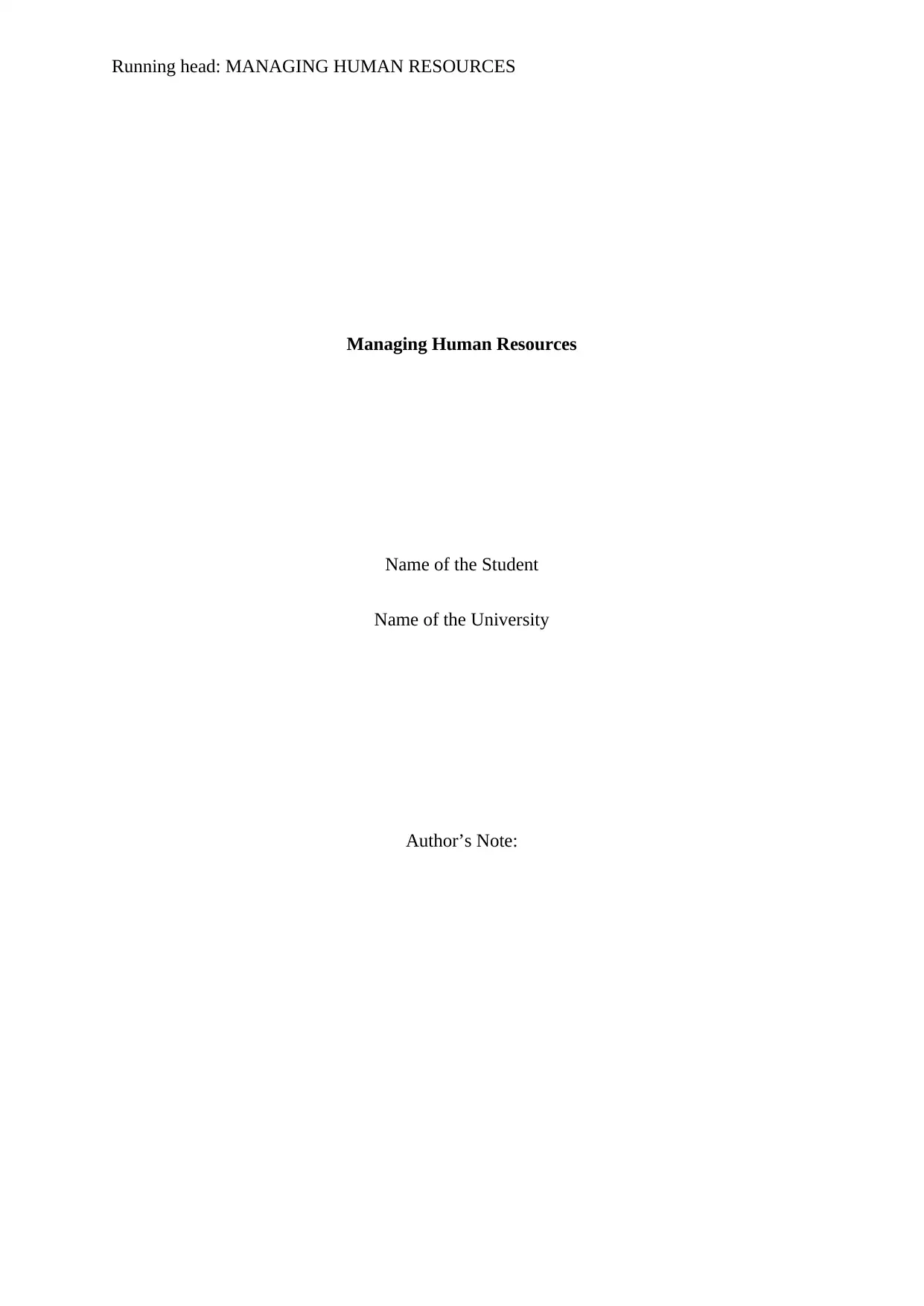
Running head: MANAGING HUMAN RESOURCES
Managing Human Resources
Name of the Student
Name of the University
Author’s Note:
Managing Human Resources
Name of the Student
Name of the University
Author’s Note:
Paraphrase This Document
Need a fresh take? Get an instant paraphrase of this document with our AI Paraphraser
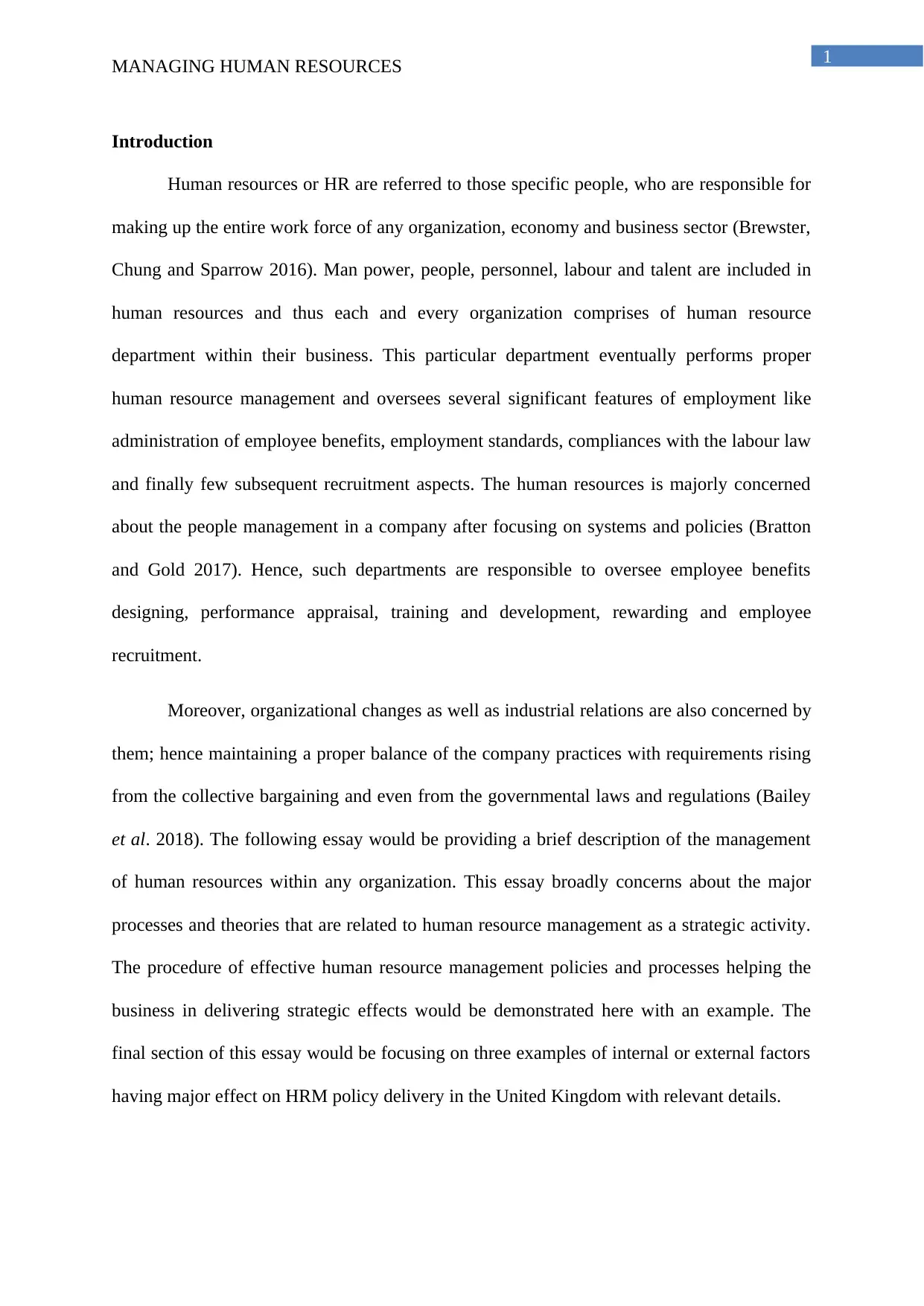
1
MANAGING HUMAN RESOURCES
Introduction
Human resources or HR are referred to those specific people, who are responsible for
making up the entire work force of any organization, economy and business sector (Brewster,
Chung and Sparrow 2016). Man power, people, personnel, labour and talent are included in
human resources and thus each and every organization comprises of human resource
department within their business. This particular department eventually performs proper
human resource management and oversees several significant features of employment like
administration of employee benefits, employment standards, compliances with the labour law
and finally few subsequent recruitment aspects. The human resources is majorly concerned
about the people management in a company after focusing on systems and policies (Bratton
and Gold 2017). Hence, such departments are responsible to oversee employee benefits
designing, performance appraisal, training and development, rewarding and employee
recruitment.
Moreover, organizational changes as well as industrial relations are also concerned by
them; hence maintaining a proper balance of the company practices with requirements rising
from the collective bargaining and even from the governmental laws and regulations (Bailey
et al. 2018). The following essay would be providing a brief description of the management
of human resources within any organization. This essay broadly concerns about the major
processes and theories that are related to human resource management as a strategic activity.
The procedure of effective human resource management policies and processes helping the
business in delivering strategic effects would be demonstrated here with an example. The
final section of this essay would be focusing on three examples of internal or external factors
having major effect on HRM policy delivery in the United Kingdom with relevant details.
MANAGING HUMAN RESOURCES
Introduction
Human resources or HR are referred to those specific people, who are responsible for
making up the entire work force of any organization, economy and business sector (Brewster,
Chung and Sparrow 2016). Man power, people, personnel, labour and talent are included in
human resources and thus each and every organization comprises of human resource
department within their business. This particular department eventually performs proper
human resource management and oversees several significant features of employment like
administration of employee benefits, employment standards, compliances with the labour law
and finally few subsequent recruitment aspects. The human resources is majorly concerned
about the people management in a company after focusing on systems and policies (Bratton
and Gold 2017). Hence, such departments are responsible to oversee employee benefits
designing, performance appraisal, training and development, rewarding and employee
recruitment.
Moreover, organizational changes as well as industrial relations are also concerned by
them; hence maintaining a proper balance of the company practices with requirements rising
from the collective bargaining and even from the governmental laws and regulations (Bailey
et al. 2018). The following essay would be providing a brief description of the management
of human resources within any organization. This essay broadly concerns about the major
processes and theories that are related to human resource management as a strategic activity.
The procedure of effective human resource management policies and processes helping the
business in delivering strategic effects would be demonstrated here with an example. The
final section of this essay would be focusing on three examples of internal or external factors
having major effect on HRM policy delivery in the United Kingdom with relevant details.
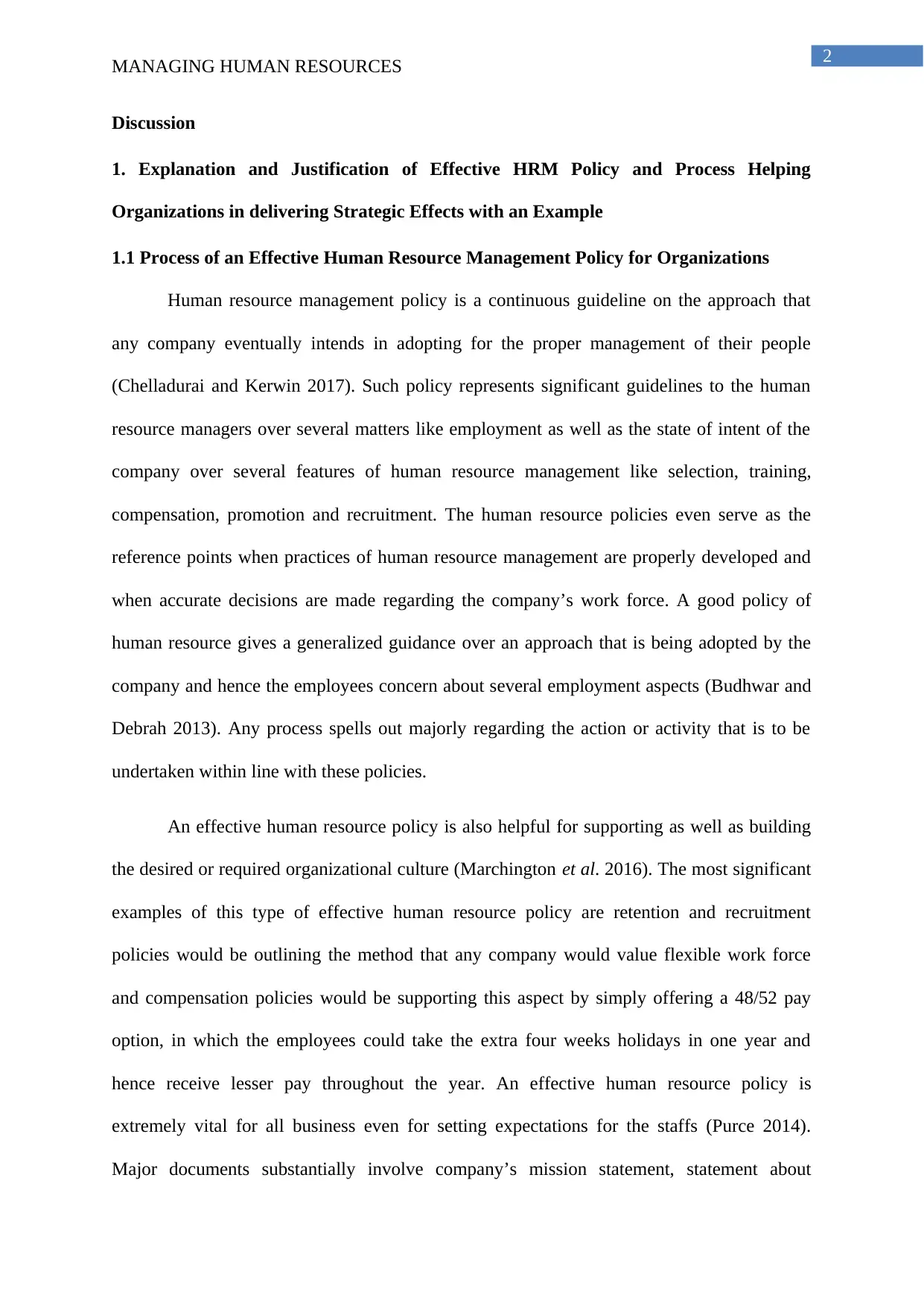
2
MANAGING HUMAN RESOURCES
Discussion
1. Explanation and Justification of Effective HRM Policy and Process Helping
Organizations in delivering Strategic Effects with an Example
1.1 Process of an Effective Human Resource Management Policy for Organizations
Human resource management policy is a continuous guideline on the approach that
any company eventually intends in adopting for the proper management of their people
(Chelladurai and Kerwin 2017). Such policy represents significant guidelines to the human
resource managers over several matters like employment as well as the state of intent of the
company over several features of human resource management like selection, training,
compensation, promotion and recruitment. The human resource policies even serve as the
reference points when practices of human resource management are properly developed and
when accurate decisions are made regarding the company’s work force. A good policy of
human resource gives a generalized guidance over an approach that is being adopted by the
company and hence the employees concern about several employment aspects (Budhwar and
Debrah 2013). Any process spells out majorly regarding the action or activity that is to be
undertaken within line with these policies.
An effective human resource policy is also helpful for supporting as well as building
the desired or required organizational culture (Marchington et al. 2016). The most significant
examples of this type of effective human resource policy are retention and recruitment
policies would be outlining the method that any company would value flexible work force
and compensation policies would be supporting this aspect by simply offering a 48/52 pay
option, in which the employees could take the extra four weeks holidays in one year and
hence receive lesser pay throughout the year. An effective human resource policy is
extremely vital for all business even for setting expectations for the staffs (Purce 2014).
Major documents substantially involve company’s mission statement, statement about
MANAGING HUMAN RESOURCES
Discussion
1. Explanation and Justification of Effective HRM Policy and Process Helping
Organizations in delivering Strategic Effects with an Example
1.1 Process of an Effective Human Resource Management Policy for Organizations
Human resource management policy is a continuous guideline on the approach that
any company eventually intends in adopting for the proper management of their people
(Chelladurai and Kerwin 2017). Such policy represents significant guidelines to the human
resource managers over several matters like employment as well as the state of intent of the
company over several features of human resource management like selection, training,
compensation, promotion and recruitment. The human resource policies even serve as the
reference points when practices of human resource management are properly developed and
when accurate decisions are made regarding the company’s work force. A good policy of
human resource gives a generalized guidance over an approach that is being adopted by the
company and hence the employees concern about several employment aspects (Budhwar and
Debrah 2013). Any process spells out majorly regarding the action or activity that is to be
undertaken within line with these policies.
An effective human resource policy is also helpful for supporting as well as building
the desired or required organizational culture (Marchington et al. 2016). The most significant
examples of this type of effective human resource policy are retention and recruitment
policies would be outlining the method that any company would value flexible work force
and compensation policies would be supporting this aspect by simply offering a 48/52 pay
option, in which the employees could take the extra four weeks holidays in one year and
hence receive lesser pay throughout the year. An effective human resource policy is
extremely vital for all business even for setting expectations for the staffs (Purce 2014).
Major documents substantially involve company’s mission statement, statement about
⊘ This is a preview!⊘
Do you want full access?
Subscribe today to unlock all pages.

Trusted by 1+ million students worldwide
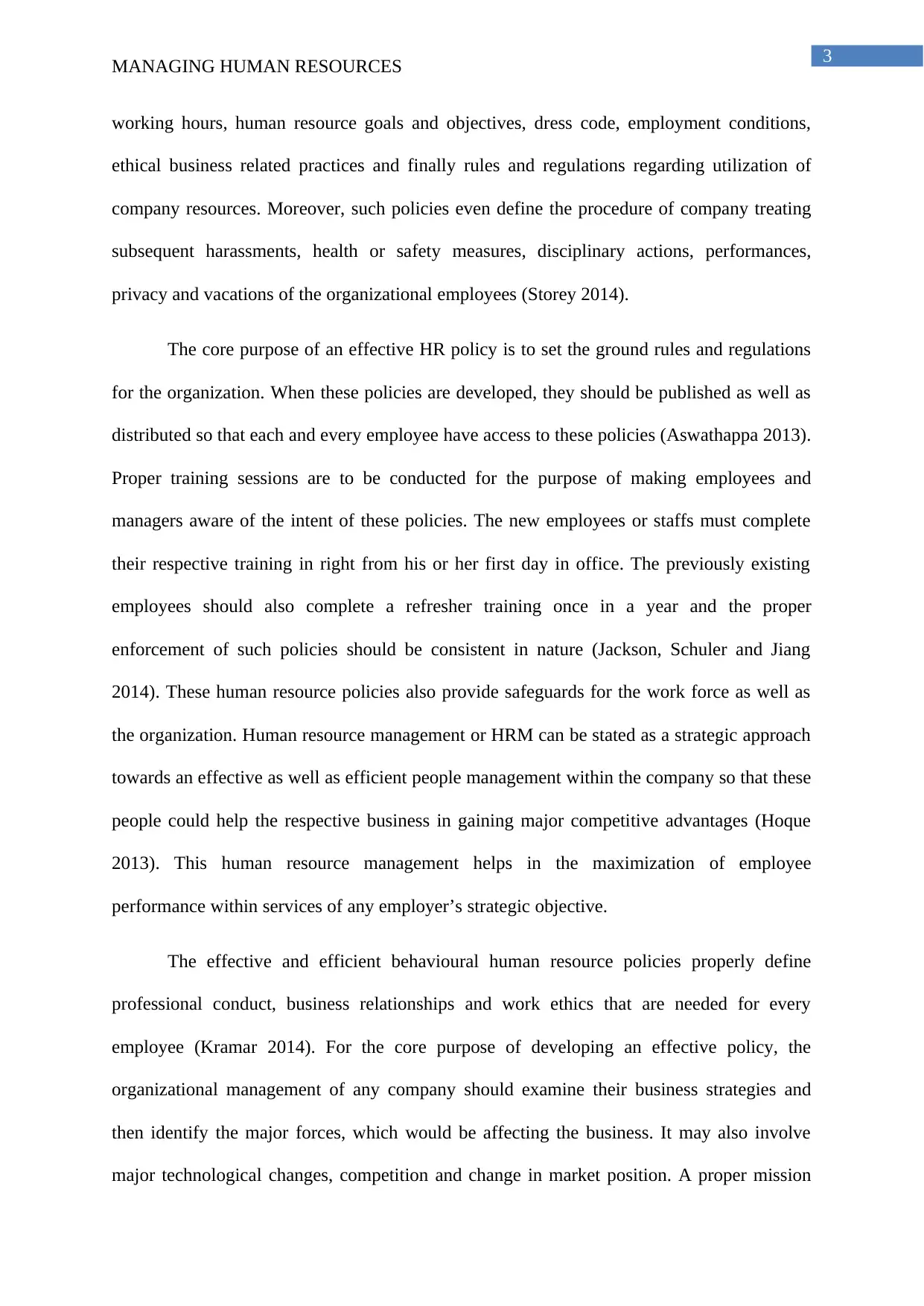
3
MANAGING HUMAN RESOURCES
working hours, human resource goals and objectives, dress code, employment conditions,
ethical business related practices and finally rules and regulations regarding utilization of
company resources. Moreover, such policies even define the procedure of company treating
subsequent harassments, health or safety measures, disciplinary actions, performances,
privacy and vacations of the organizational employees (Storey 2014).
The core purpose of an effective HR policy is to set the ground rules and regulations
for the organization. When these policies are developed, they should be published as well as
distributed so that each and every employee have access to these policies (Aswathappa 2013).
Proper training sessions are to be conducted for the purpose of making employees and
managers aware of the intent of these policies. The new employees or staffs must complete
their respective training in right from his or her first day in office. The previously existing
employees should also complete a refresher training once in a year and the proper
enforcement of such policies should be consistent in nature (Jackson, Schuler and Jiang
2014). These human resource policies also provide safeguards for the work force as well as
the organization. Human resource management or HRM can be stated as a strategic approach
towards an effective as well as efficient people management within the company so that these
people could help the respective business in gaining major competitive advantages (Hoque
2013). This human resource management helps in the maximization of employee
performance within services of any employer’s strategic objective.
The effective and efficient behavioural human resource policies properly define
professional conduct, business relationships and work ethics that are needed for every
employee (Kramar 2014). For the core purpose of developing an effective policy, the
organizational management of any company should examine their business strategies and
then identify the major forces, which would be affecting the business. It may also involve
major technological changes, competition and change in market position. A proper mission
MANAGING HUMAN RESOURCES
working hours, human resource goals and objectives, dress code, employment conditions,
ethical business related practices and finally rules and regulations regarding utilization of
company resources. Moreover, such policies even define the procedure of company treating
subsequent harassments, health or safety measures, disciplinary actions, performances,
privacy and vacations of the organizational employees (Storey 2014).
The core purpose of an effective HR policy is to set the ground rules and regulations
for the organization. When these policies are developed, they should be published as well as
distributed so that each and every employee have access to these policies (Aswathappa 2013).
Proper training sessions are to be conducted for the purpose of making employees and
managers aware of the intent of these policies. The new employees or staffs must complete
their respective training in right from his or her first day in office. The previously existing
employees should also complete a refresher training once in a year and the proper
enforcement of such policies should be consistent in nature (Jackson, Schuler and Jiang
2014). These human resource policies also provide safeguards for the work force as well as
the organization. Human resource management or HRM can be stated as a strategic approach
towards an effective as well as efficient people management within the company so that these
people could help the respective business in gaining major competitive advantages (Hoque
2013). This human resource management helps in the maximization of employee
performance within services of any employer’s strategic objective.
The effective and efficient behavioural human resource policies properly define
professional conduct, business relationships and work ethics that are needed for every
employee (Kramar 2014). For the core purpose of developing an effective policy, the
organizational management of any company should examine their business strategies and
then identify the major forces, which would be affecting the business. It may also involve
major technological changes, competition and change in market position. A proper mission
Paraphrase This Document
Need a fresh take? Get an instant paraphrase of this document with our AI Paraphraser
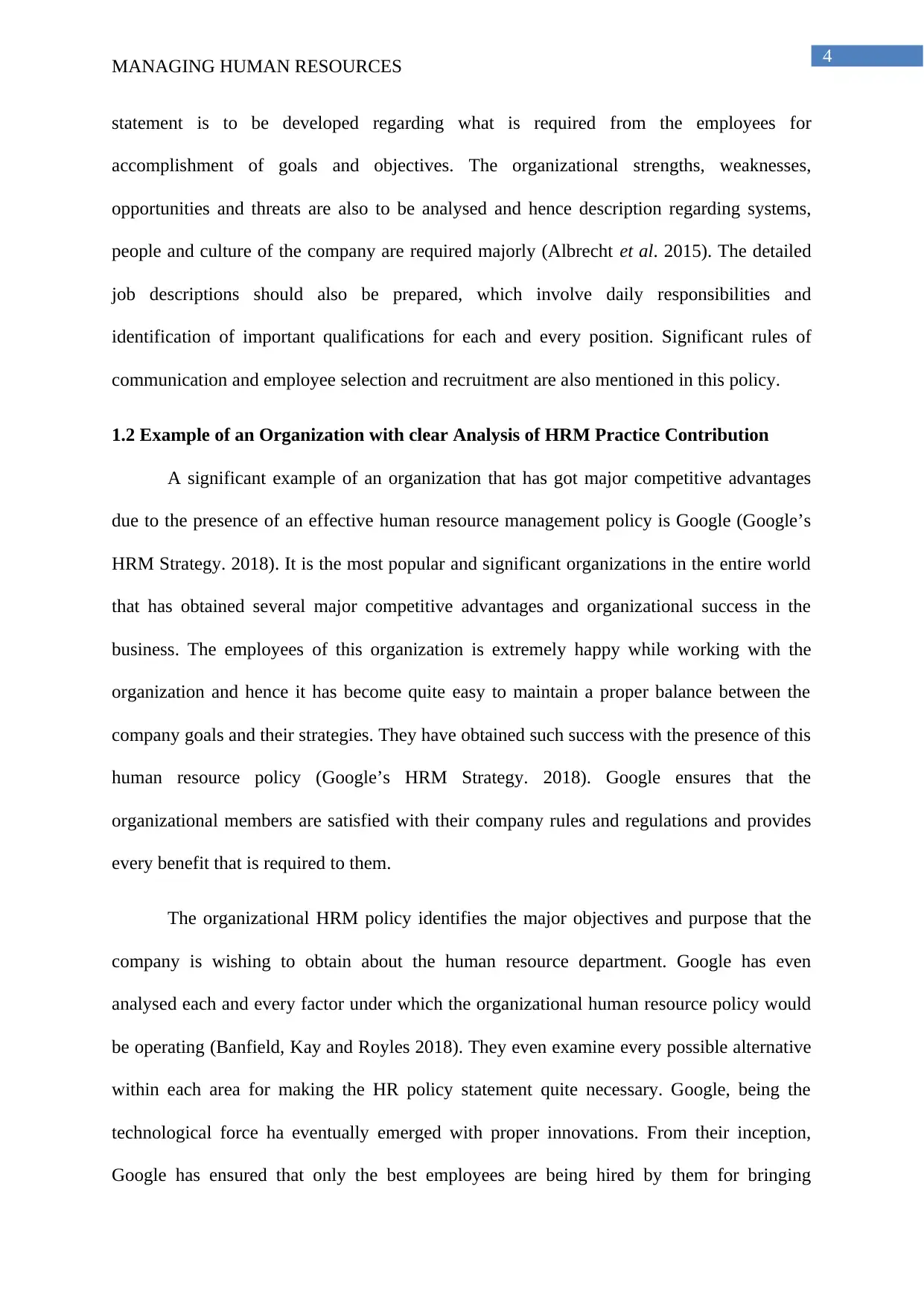
4
MANAGING HUMAN RESOURCES
statement is to be developed regarding what is required from the employees for
accomplishment of goals and objectives. The organizational strengths, weaknesses,
opportunities and threats are also to be analysed and hence description regarding systems,
people and culture of the company are required majorly (Albrecht et al. 2015). The detailed
job descriptions should also be prepared, which involve daily responsibilities and
identification of important qualifications for each and every position. Significant rules of
communication and employee selection and recruitment are also mentioned in this policy.
1.2 Example of an Organization with clear Analysis of HRM Practice Contribution
A significant example of an organization that has got major competitive advantages
due to the presence of an effective human resource management policy is Google (Google’s
HRM Strategy. 2018). It is the most popular and significant organizations in the entire world
that has obtained several major competitive advantages and organizational success in the
business. The employees of this organization is extremely happy while working with the
organization and hence it has become quite easy to maintain a proper balance between the
company goals and their strategies. They have obtained such success with the presence of this
human resource policy (Google’s HRM Strategy. 2018). Google ensures that the
organizational members are satisfied with their company rules and regulations and provides
every benefit that is required to them.
The organizational HRM policy identifies the major objectives and purpose that the
company is wishing to obtain about the human resource department. Google has even
analysed each and every factor under which the organizational human resource policy would
be operating (Banfield, Kay and Royles 2018). They even examine every possible alternative
within each area for making the HR policy statement quite necessary. Google, being the
technological force ha eventually emerged with proper innovations. From their inception,
Google has ensured that only the best employees are being hired by them for bringing
MANAGING HUMAN RESOURCES
statement is to be developed regarding what is required from the employees for
accomplishment of goals and objectives. The organizational strengths, weaknesses,
opportunities and threats are also to be analysed and hence description regarding systems,
people and culture of the company are required majorly (Albrecht et al. 2015). The detailed
job descriptions should also be prepared, which involve daily responsibilities and
identification of important qualifications for each and every position. Significant rules of
communication and employee selection and recruitment are also mentioned in this policy.
1.2 Example of an Organization with clear Analysis of HRM Practice Contribution
A significant example of an organization that has got major competitive advantages
due to the presence of an effective human resource management policy is Google (Google’s
HRM Strategy. 2018). It is the most popular and significant organizations in the entire world
that has obtained several major competitive advantages and organizational success in the
business. The employees of this organization is extremely happy while working with the
organization and hence it has become quite easy to maintain a proper balance between the
company goals and their strategies. They have obtained such success with the presence of this
human resource policy (Google’s HRM Strategy. 2018). Google ensures that the
organizational members are satisfied with their company rules and regulations and provides
every benefit that is required to them.
The organizational HRM policy identifies the major objectives and purpose that the
company is wishing to obtain about the human resource department. Google has even
analysed each and every factor under which the organizational human resource policy would
be operating (Banfield, Kay and Royles 2018). They even examine every possible alternative
within each area for making the HR policy statement quite necessary. Google, being the
technological force ha eventually emerged with proper innovations. From their inception,
Google has ensured that only the best employees are being hired by them for bringing
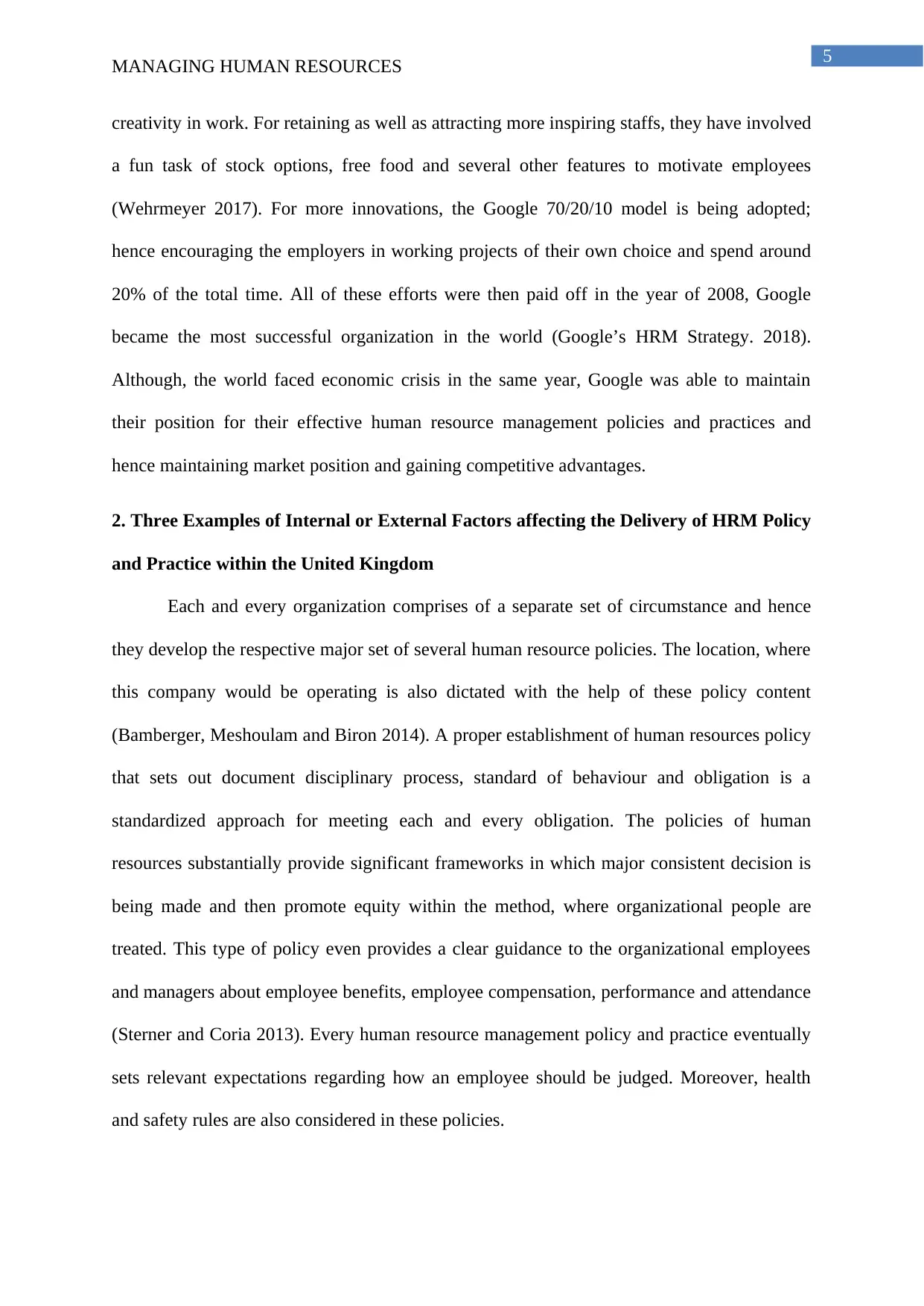
5
MANAGING HUMAN RESOURCES
creativity in work. For retaining as well as attracting more inspiring staffs, they have involved
a fun task of stock options, free food and several other features to motivate employees
(Wehrmeyer 2017). For more innovations, the Google 70/20/10 model is being adopted;
hence encouraging the employers in working projects of their own choice and spend around
20% of the total time. All of these efforts were then paid off in the year of 2008, Google
became the most successful organization in the world (Google’s HRM Strategy. 2018).
Although, the world faced economic crisis in the same year, Google was able to maintain
their position for their effective human resource management policies and practices and
hence maintaining market position and gaining competitive advantages.
2. Three Examples of Internal or External Factors affecting the Delivery of HRM Policy
and Practice within the United Kingdom
Each and every organization comprises of a separate set of circumstance and hence
they develop the respective major set of several human resource policies. The location, where
this company would be operating is also dictated with the help of these policy content
(Bamberger, Meshoulam and Biron 2014). A proper establishment of human resources policy
that sets out document disciplinary process, standard of behaviour and obligation is a
standardized approach for meeting each and every obligation. The policies of human
resources substantially provide significant frameworks in which major consistent decision is
being made and then promote equity within the method, where organizational people are
treated. This type of policy even provides a clear guidance to the organizational employees
and managers about employee benefits, employee compensation, performance and attendance
(Sterner and Coria 2013). Every human resource management policy and practice eventually
sets relevant expectations regarding how an employee should be judged. Moreover, health
and safety rules are also considered in these policies.
MANAGING HUMAN RESOURCES
creativity in work. For retaining as well as attracting more inspiring staffs, they have involved
a fun task of stock options, free food and several other features to motivate employees
(Wehrmeyer 2017). For more innovations, the Google 70/20/10 model is being adopted;
hence encouraging the employers in working projects of their own choice and spend around
20% of the total time. All of these efforts were then paid off in the year of 2008, Google
became the most successful organization in the world (Google’s HRM Strategy. 2018).
Although, the world faced economic crisis in the same year, Google was able to maintain
their position for their effective human resource management policies and practices and
hence maintaining market position and gaining competitive advantages.
2. Three Examples of Internal or External Factors affecting the Delivery of HRM Policy
and Practice within the United Kingdom
Each and every organization comprises of a separate set of circumstance and hence
they develop the respective major set of several human resource policies. The location, where
this company would be operating is also dictated with the help of these policy content
(Bamberger, Meshoulam and Biron 2014). A proper establishment of human resources policy
that sets out document disciplinary process, standard of behaviour and obligation is a
standardized approach for meeting each and every obligation. The policies of human
resources substantially provide significant frameworks in which major consistent decision is
being made and then promote equity within the method, where organizational people are
treated. This type of policy even provides a clear guidance to the organizational employees
and managers about employee benefits, employee compensation, performance and attendance
(Sterner and Coria 2013). Every human resource management policy and practice eventually
sets relevant expectations regarding how an employee should be judged. Moreover, health
and safety rules are also considered in these policies.
⊘ This is a preview!⊘
Do you want full access?
Subscribe today to unlock all pages.

Trusted by 1+ million students worldwide
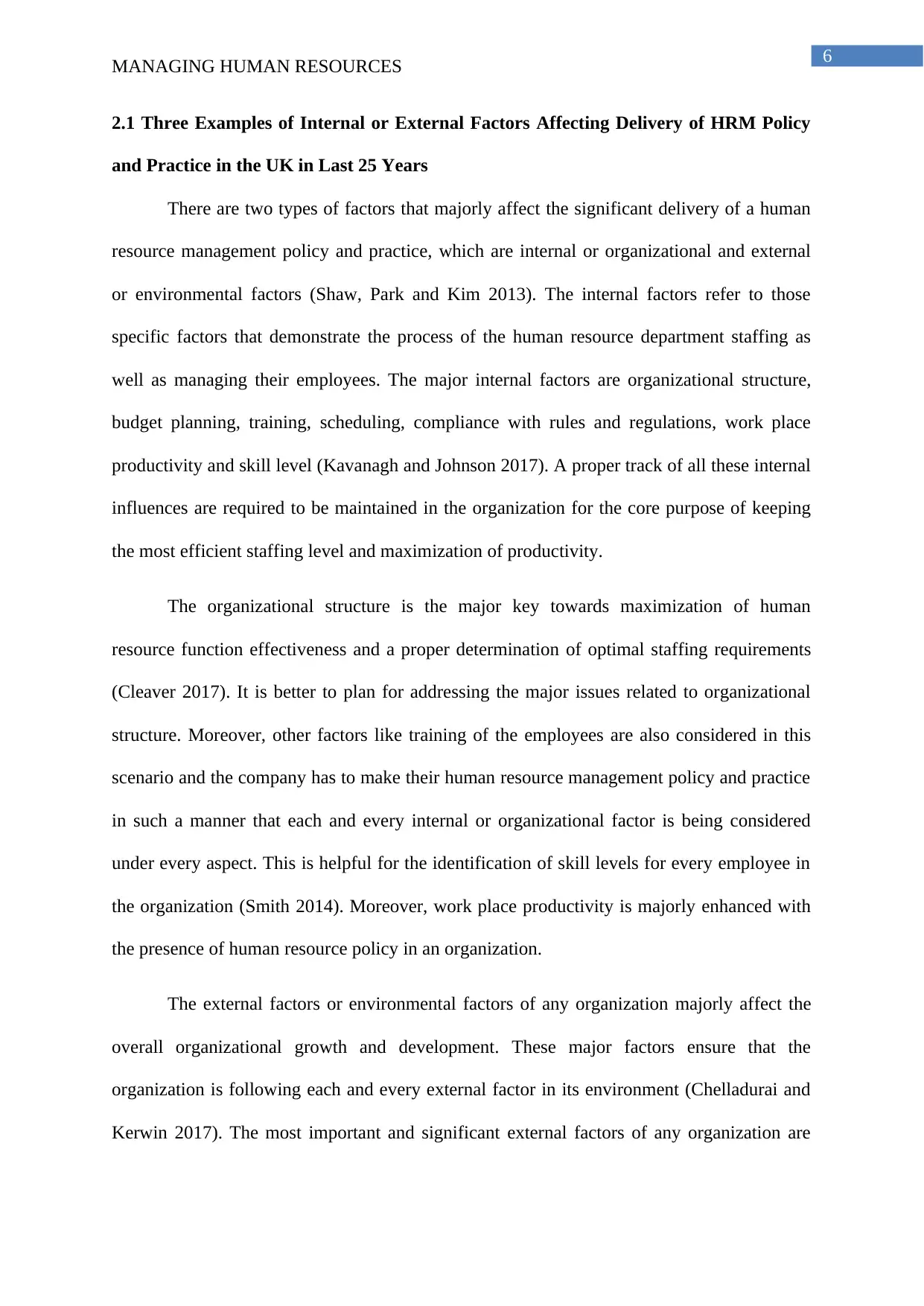
6
MANAGING HUMAN RESOURCES
2.1 Three Examples of Internal or External Factors Affecting Delivery of HRM Policy
and Practice in the UK in Last 25 Years
There are two types of factors that majorly affect the significant delivery of a human
resource management policy and practice, which are internal or organizational and external
or environmental factors (Shaw, Park and Kim 2013). The internal factors refer to those
specific factors that demonstrate the process of the human resource department staffing as
well as managing their employees. The major internal factors are organizational structure,
budget planning, training, scheduling, compliance with rules and regulations, work place
productivity and skill level (Kavanagh and Johnson 2017). A proper track of all these internal
influences are required to be maintained in the organization for the core purpose of keeping
the most efficient staffing level and maximization of productivity.
The organizational structure is the major key towards maximization of human
resource function effectiveness and a proper determination of optimal staffing requirements
(Cleaver 2017). It is better to plan for addressing the major issues related to organizational
structure. Moreover, other factors like training of the employees are also considered in this
scenario and the company has to make their human resource management policy and practice
in such a manner that each and every internal or organizational factor is being considered
under every aspect. This is helpful for the identification of skill levels for every employee in
the organization (Smith 2014). Moreover, work place productivity is majorly enhanced with
the presence of human resource policy in an organization.
The external factors or environmental factors of any organization majorly affect the
overall organizational growth and development. These major factors ensure that the
organization is following each and every external factor in its environment (Chelladurai and
Kerwin 2017). The most important and significant external factors of any organization are
MANAGING HUMAN RESOURCES
2.1 Three Examples of Internal or External Factors Affecting Delivery of HRM Policy
and Practice in the UK in Last 25 Years
There are two types of factors that majorly affect the significant delivery of a human
resource management policy and practice, which are internal or organizational and external
or environmental factors (Shaw, Park and Kim 2013). The internal factors refer to those
specific factors that demonstrate the process of the human resource department staffing as
well as managing their employees. The major internal factors are organizational structure,
budget planning, training, scheduling, compliance with rules and regulations, work place
productivity and skill level (Kavanagh and Johnson 2017). A proper track of all these internal
influences are required to be maintained in the organization for the core purpose of keeping
the most efficient staffing level and maximization of productivity.
The organizational structure is the major key towards maximization of human
resource function effectiveness and a proper determination of optimal staffing requirements
(Cleaver 2017). It is better to plan for addressing the major issues related to organizational
structure. Moreover, other factors like training of the employees are also considered in this
scenario and the company has to make their human resource management policy and practice
in such a manner that each and every internal or organizational factor is being considered
under every aspect. This is helpful for the identification of skill levels for every employee in
the organization (Smith 2014). Moreover, work place productivity is majorly enhanced with
the presence of human resource policy in an organization.
The external factors or environmental factors of any organization majorly affect the
overall organizational growth and development. These major factors ensure that the
organization is following each and every external factor in its environment (Chelladurai and
Kerwin 2017). The most important and significant external factors of any organization are
Paraphrase This Document
Need a fresh take? Get an instant paraphrase of this document with our AI Paraphraser
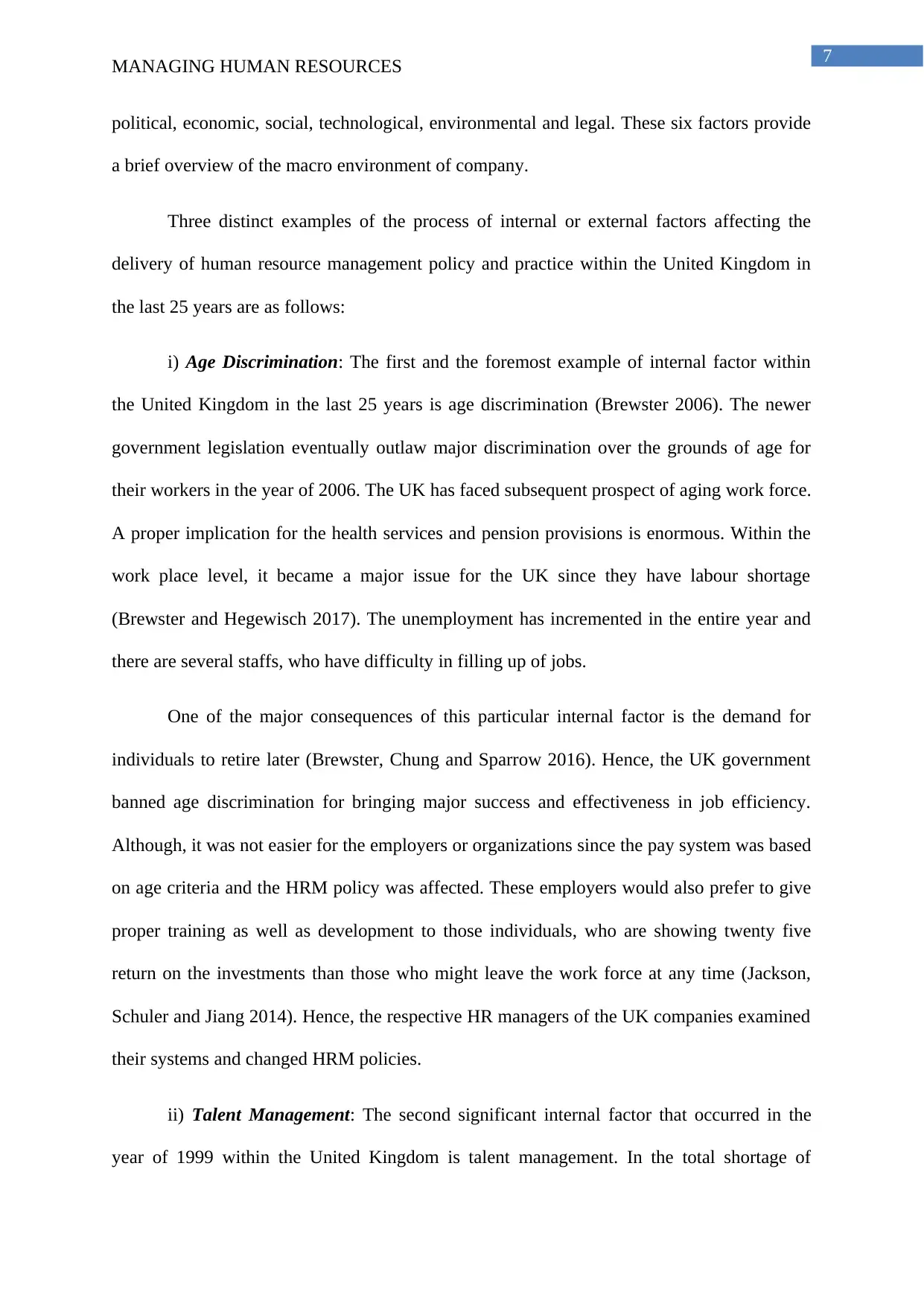
7
MANAGING HUMAN RESOURCES
political, economic, social, technological, environmental and legal. These six factors provide
a brief overview of the macro environment of company.
Three distinct examples of the process of internal or external factors affecting the
delivery of human resource management policy and practice within the United Kingdom in
the last 25 years are as follows:
i) Age Discrimination: The first and the foremost example of internal factor within
the United Kingdom in the last 25 years is age discrimination (Brewster 2006). The newer
government legislation eventually outlaw major discrimination over the grounds of age for
their workers in the year of 2006. The UK has faced subsequent prospect of aging work force.
A proper implication for the health services and pension provisions is enormous. Within the
work place level, it became a major issue for the UK since they have labour shortage
(Brewster and Hegewisch 2017). The unemployment has incremented in the entire year and
there are several staffs, who have difficulty in filling up of jobs.
One of the major consequences of this particular internal factor is the demand for
individuals to retire later (Brewster, Chung and Sparrow 2016). Hence, the UK government
banned age discrimination for bringing major success and effectiveness in job efficiency.
Although, it was not easier for the employers or organizations since the pay system was based
on age criteria and the HRM policy was affected. These employers would also prefer to give
proper training as well as development to those individuals, who are showing twenty five
return on the investments than those who might leave the work force at any time (Jackson,
Schuler and Jiang 2014). Hence, the respective HR managers of the UK companies examined
their systems and changed HRM policies.
ii) Talent Management: The second significant internal factor that occurred in the
year of 1999 within the United Kingdom is talent management. In the total shortage of
MANAGING HUMAN RESOURCES
political, economic, social, technological, environmental and legal. These six factors provide
a brief overview of the macro environment of company.
Three distinct examples of the process of internal or external factors affecting the
delivery of human resource management policy and practice within the United Kingdom in
the last 25 years are as follows:
i) Age Discrimination: The first and the foremost example of internal factor within
the United Kingdom in the last 25 years is age discrimination (Brewster 2006). The newer
government legislation eventually outlaw major discrimination over the grounds of age for
their workers in the year of 2006. The UK has faced subsequent prospect of aging work force.
A proper implication for the health services and pension provisions is enormous. Within the
work place level, it became a major issue for the UK since they have labour shortage
(Brewster and Hegewisch 2017). The unemployment has incremented in the entire year and
there are several staffs, who have difficulty in filling up of jobs.
One of the major consequences of this particular internal factor is the demand for
individuals to retire later (Brewster, Chung and Sparrow 2016). Hence, the UK government
banned age discrimination for bringing major success and effectiveness in job efficiency.
Although, it was not easier for the employers or organizations since the pay system was based
on age criteria and the HRM policy was affected. These employers would also prefer to give
proper training as well as development to those individuals, who are showing twenty five
return on the investments than those who might leave the work force at any time (Jackson,
Schuler and Jiang 2014). Hence, the respective HR managers of the UK companies examined
their systems and changed HRM policies.
ii) Talent Management: The second significant internal factor that occurred in the
year of 1999 within the United Kingdom is talent management. In the total shortage of
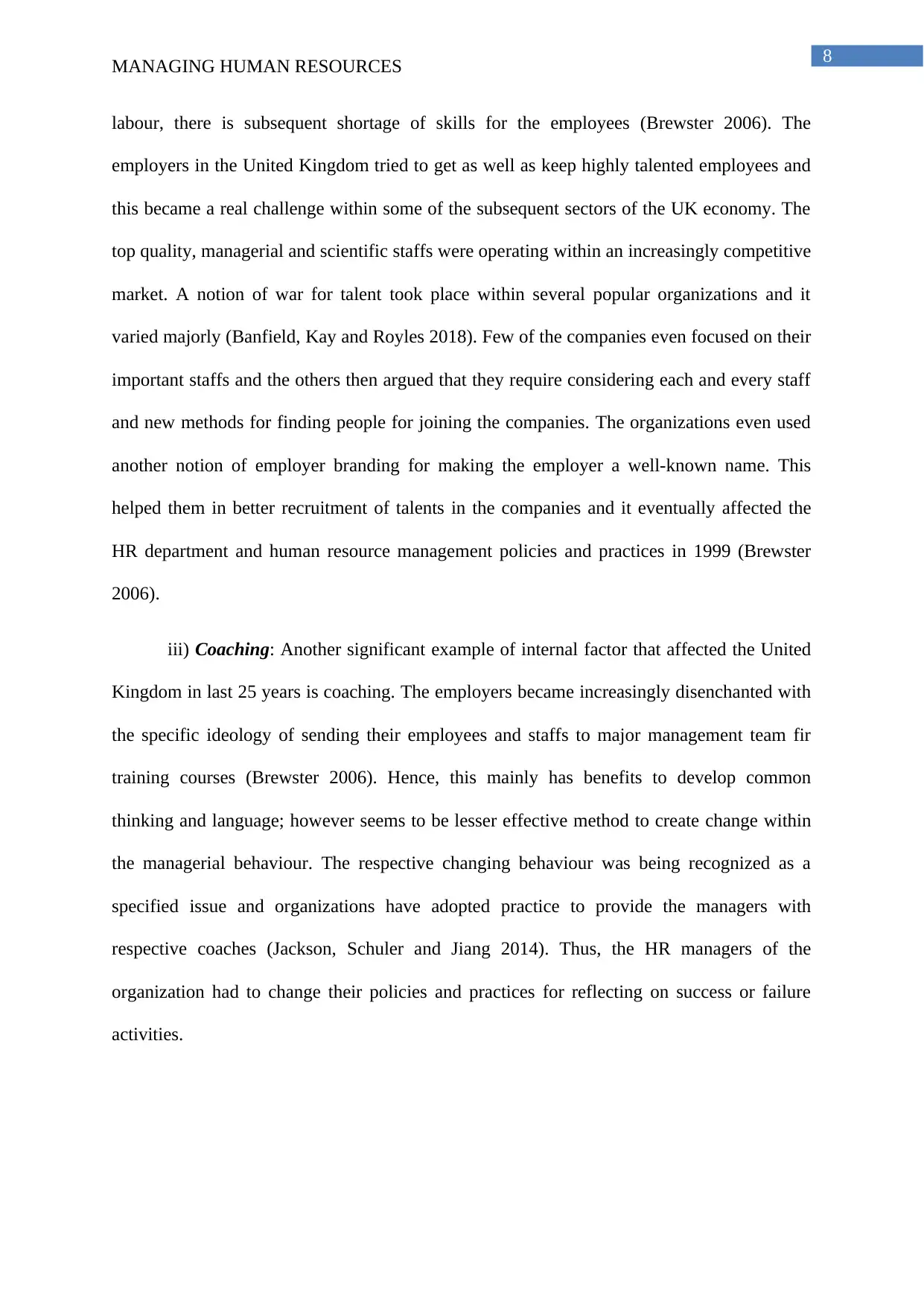
8
MANAGING HUMAN RESOURCES
labour, there is subsequent shortage of skills for the employees (Brewster 2006). The
employers in the United Kingdom tried to get as well as keep highly talented employees and
this became a real challenge within some of the subsequent sectors of the UK economy. The
top quality, managerial and scientific staffs were operating within an increasingly competitive
market. A notion of war for talent took place within several popular organizations and it
varied majorly (Banfield, Kay and Royles 2018). Few of the companies even focused on their
important staffs and the others then argued that they require considering each and every staff
and new methods for finding people for joining the companies. The organizations even used
another notion of employer branding for making the employer a well-known name. This
helped them in better recruitment of talents in the companies and it eventually affected the
HR department and human resource management policies and practices in 1999 (Brewster
2006).
iii) Coaching: Another significant example of internal factor that affected the United
Kingdom in last 25 years is coaching. The employers became increasingly disenchanted with
the specific ideology of sending their employees and staffs to major management team fir
training courses (Brewster 2006). Hence, this mainly has benefits to develop common
thinking and language; however seems to be lesser effective method to create change within
the managerial behaviour. The respective changing behaviour was being recognized as a
specified issue and organizations have adopted practice to provide the managers with
respective coaches (Jackson, Schuler and Jiang 2014). Thus, the HR managers of the
organization had to change their policies and practices for reflecting on success or failure
activities.
MANAGING HUMAN RESOURCES
labour, there is subsequent shortage of skills for the employees (Brewster 2006). The
employers in the United Kingdom tried to get as well as keep highly talented employees and
this became a real challenge within some of the subsequent sectors of the UK economy. The
top quality, managerial and scientific staffs were operating within an increasingly competitive
market. A notion of war for talent took place within several popular organizations and it
varied majorly (Banfield, Kay and Royles 2018). Few of the companies even focused on their
important staffs and the others then argued that they require considering each and every staff
and new methods for finding people for joining the companies. The organizations even used
another notion of employer branding for making the employer a well-known name. This
helped them in better recruitment of talents in the companies and it eventually affected the
HR department and human resource management policies and practices in 1999 (Brewster
2006).
iii) Coaching: Another significant example of internal factor that affected the United
Kingdom in last 25 years is coaching. The employers became increasingly disenchanted with
the specific ideology of sending their employees and staffs to major management team fir
training courses (Brewster 2006). Hence, this mainly has benefits to develop common
thinking and language; however seems to be lesser effective method to create change within
the managerial behaviour. The respective changing behaviour was being recognized as a
specified issue and organizations have adopted practice to provide the managers with
respective coaches (Jackson, Schuler and Jiang 2014). Thus, the HR managers of the
organization had to change their policies and practices for reflecting on success or failure
activities.
⊘ This is a preview!⊘
Do you want full access?
Subscribe today to unlock all pages.

Trusted by 1+ million students worldwide
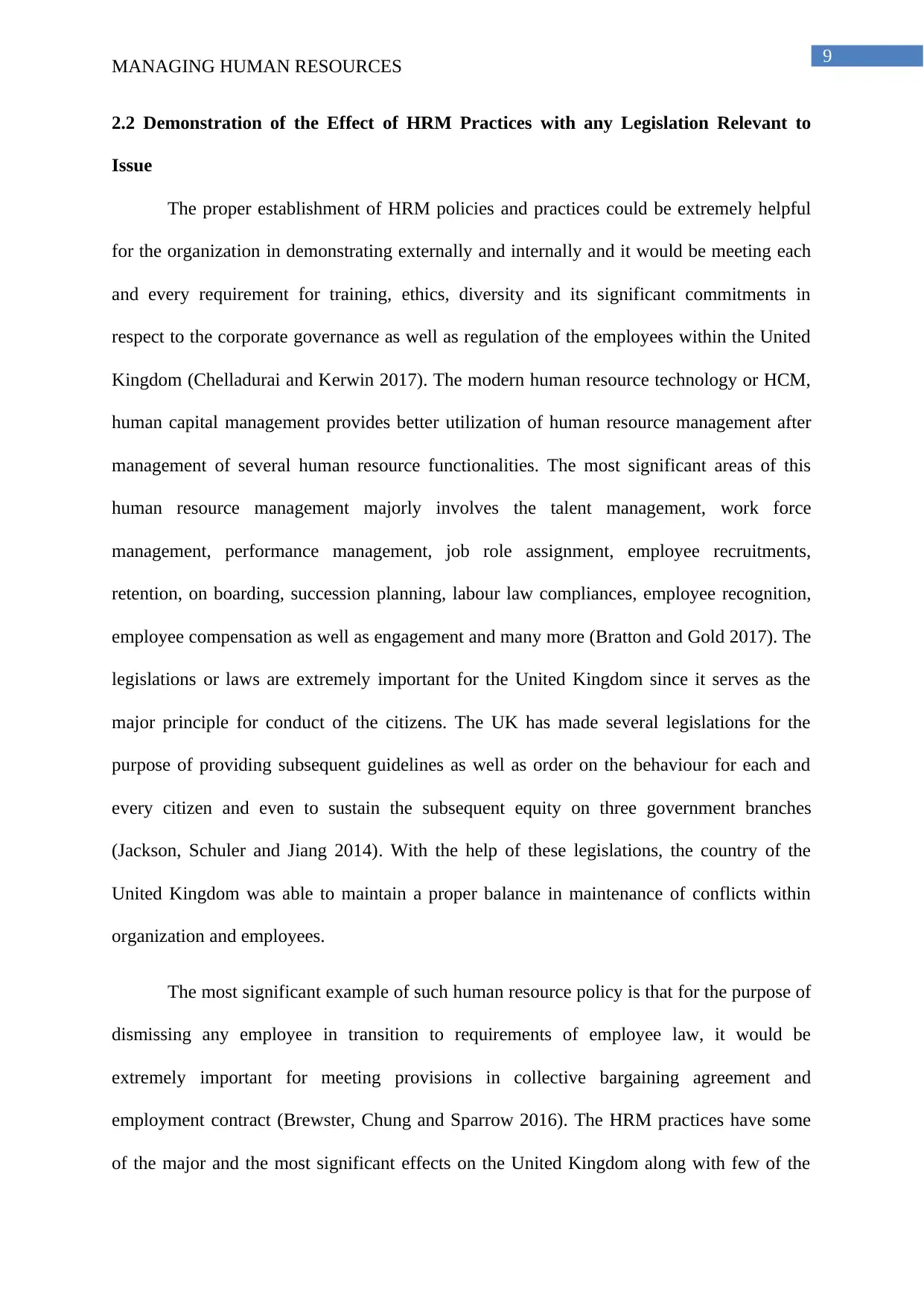
9
MANAGING HUMAN RESOURCES
2.2 Demonstration of the Effect of HRM Practices with any Legislation Relevant to
Issue
The proper establishment of HRM policies and practices could be extremely helpful
for the organization in demonstrating externally and internally and it would be meeting each
and every requirement for training, ethics, diversity and its significant commitments in
respect to the corporate governance as well as regulation of the employees within the United
Kingdom (Chelladurai and Kerwin 2017). The modern human resource technology or HCM,
human capital management provides better utilization of human resource management after
management of several human resource functionalities. The most significant areas of this
human resource management majorly involves the talent management, work force
management, performance management, job role assignment, employee recruitments,
retention, on boarding, succession planning, labour law compliances, employee recognition,
employee compensation as well as engagement and many more (Bratton and Gold 2017). The
legislations or laws are extremely important for the United Kingdom since it serves as the
major principle for conduct of the citizens. The UK has made several legislations for the
purpose of providing subsequent guidelines as well as order on the behaviour for each and
every citizen and even to sustain the subsequent equity on three government branches
(Jackson, Schuler and Jiang 2014). With the help of these legislations, the country of the
United Kingdom was able to maintain a proper balance in maintenance of conflicts within
organization and employees.
The most significant example of such human resource policy is that for the purpose of
dismissing any employee in transition to requirements of employee law, it would be
extremely important for meeting provisions in collective bargaining agreement and
employment contract (Brewster, Chung and Sparrow 2016). The HRM practices have some
of the major and the most significant effects on the United Kingdom along with few of the
MANAGING HUMAN RESOURCES
2.2 Demonstration of the Effect of HRM Practices with any Legislation Relevant to
Issue
The proper establishment of HRM policies and practices could be extremely helpful
for the organization in demonstrating externally and internally and it would be meeting each
and every requirement for training, ethics, diversity and its significant commitments in
respect to the corporate governance as well as regulation of the employees within the United
Kingdom (Chelladurai and Kerwin 2017). The modern human resource technology or HCM,
human capital management provides better utilization of human resource management after
management of several human resource functionalities. The most significant areas of this
human resource management majorly involves the talent management, work force
management, performance management, job role assignment, employee recruitments,
retention, on boarding, succession planning, labour law compliances, employee recognition,
employee compensation as well as engagement and many more (Bratton and Gold 2017). The
legislations or laws are extremely important for the United Kingdom since it serves as the
major principle for conduct of the citizens. The UK has made several legislations for the
purpose of providing subsequent guidelines as well as order on the behaviour for each and
every citizen and even to sustain the subsequent equity on three government branches
(Jackson, Schuler and Jiang 2014). With the help of these legislations, the country of the
United Kingdom was able to maintain a proper balance in maintenance of conflicts within
organization and employees.
The most significant example of such human resource policy is that for the purpose of
dismissing any employee in transition to requirements of employee law, it would be
extremely important for meeting provisions in collective bargaining agreement and
employment contract (Brewster, Chung and Sparrow 2016). The HRM practices have some
of the major and the most significant effects on the United Kingdom along with few of the
Paraphrase This Document
Need a fresh take? Get an instant paraphrase of this document with our AI Paraphraser
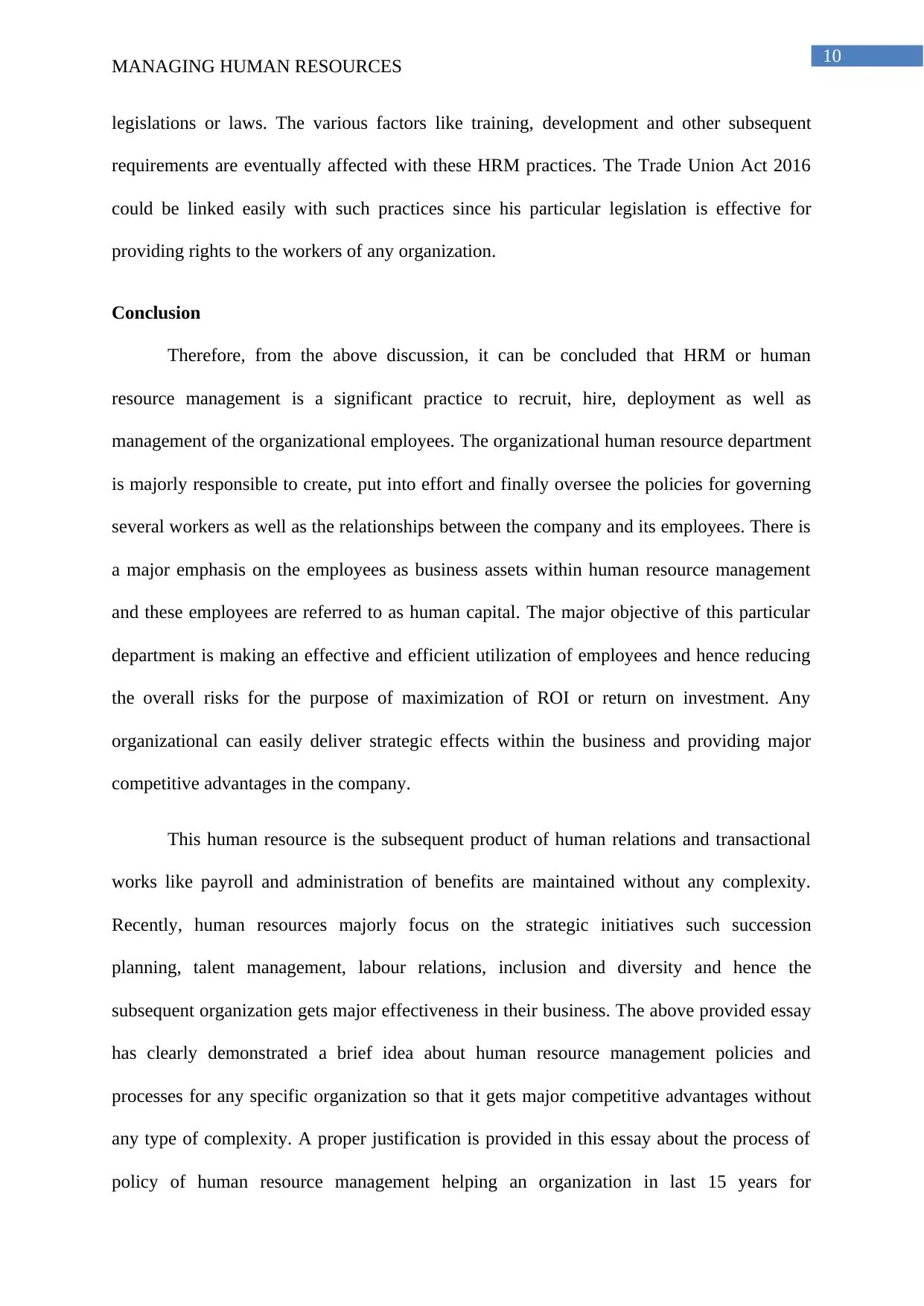
10
MANAGING HUMAN RESOURCES
legislations or laws. The various factors like training, development and other subsequent
requirements are eventually affected with these HRM practices. The Trade Union Act 2016
could be linked easily with such practices since his particular legislation is effective for
providing rights to the workers of any organization.
Conclusion
Therefore, from the above discussion, it can be concluded that HRM or human
resource management is a significant practice to recruit, hire, deployment as well as
management of the organizational employees. The organizational human resource department
is majorly responsible to create, put into effort and finally oversee the policies for governing
several workers as well as the relationships between the company and its employees. There is
a major emphasis on the employees as business assets within human resource management
and these employees are referred to as human capital. The major objective of this particular
department is making an effective and efficient utilization of employees and hence reducing
the overall risks for the purpose of maximization of ROI or return on investment. Any
organizational can easily deliver strategic effects within the business and providing major
competitive advantages in the company.
This human resource is the subsequent product of human relations and transactional
works like payroll and administration of benefits are maintained without any complexity.
Recently, human resources majorly focus on the strategic initiatives such succession
planning, talent management, labour relations, inclusion and diversity and hence the
subsequent organization gets major effectiveness in their business. The above provided essay
has clearly demonstrated a brief idea about human resource management policies and
processes for any specific organization so that it gets major competitive advantages without
any type of complexity. A proper justification is provided in this essay about the process of
policy of human resource management helping an organization in last 15 years for
MANAGING HUMAN RESOURCES
legislations or laws. The various factors like training, development and other subsequent
requirements are eventually affected with these HRM practices. The Trade Union Act 2016
could be linked easily with such practices since his particular legislation is effective for
providing rights to the workers of any organization.
Conclusion
Therefore, from the above discussion, it can be concluded that HRM or human
resource management is a significant practice to recruit, hire, deployment as well as
management of the organizational employees. The organizational human resource department
is majorly responsible to create, put into effort and finally oversee the policies for governing
several workers as well as the relationships between the company and its employees. There is
a major emphasis on the employees as business assets within human resource management
and these employees are referred to as human capital. The major objective of this particular
department is making an effective and efficient utilization of employees and hence reducing
the overall risks for the purpose of maximization of ROI or return on investment. Any
organizational can easily deliver strategic effects within the business and providing major
competitive advantages in the company.
This human resource is the subsequent product of human relations and transactional
works like payroll and administration of benefits are maintained without any complexity.
Recently, human resources majorly focus on the strategic initiatives such succession
planning, talent management, labour relations, inclusion and diversity and hence the
subsequent organization gets major effectiveness in their business. The above provided essay
has clearly demonstrated a brief idea about human resource management policies and
processes for any specific organization so that it gets major competitive advantages without
any type of complexity. A proper justification is provided in this essay about the process of
policy of human resource management helping an organization in last 15 years for
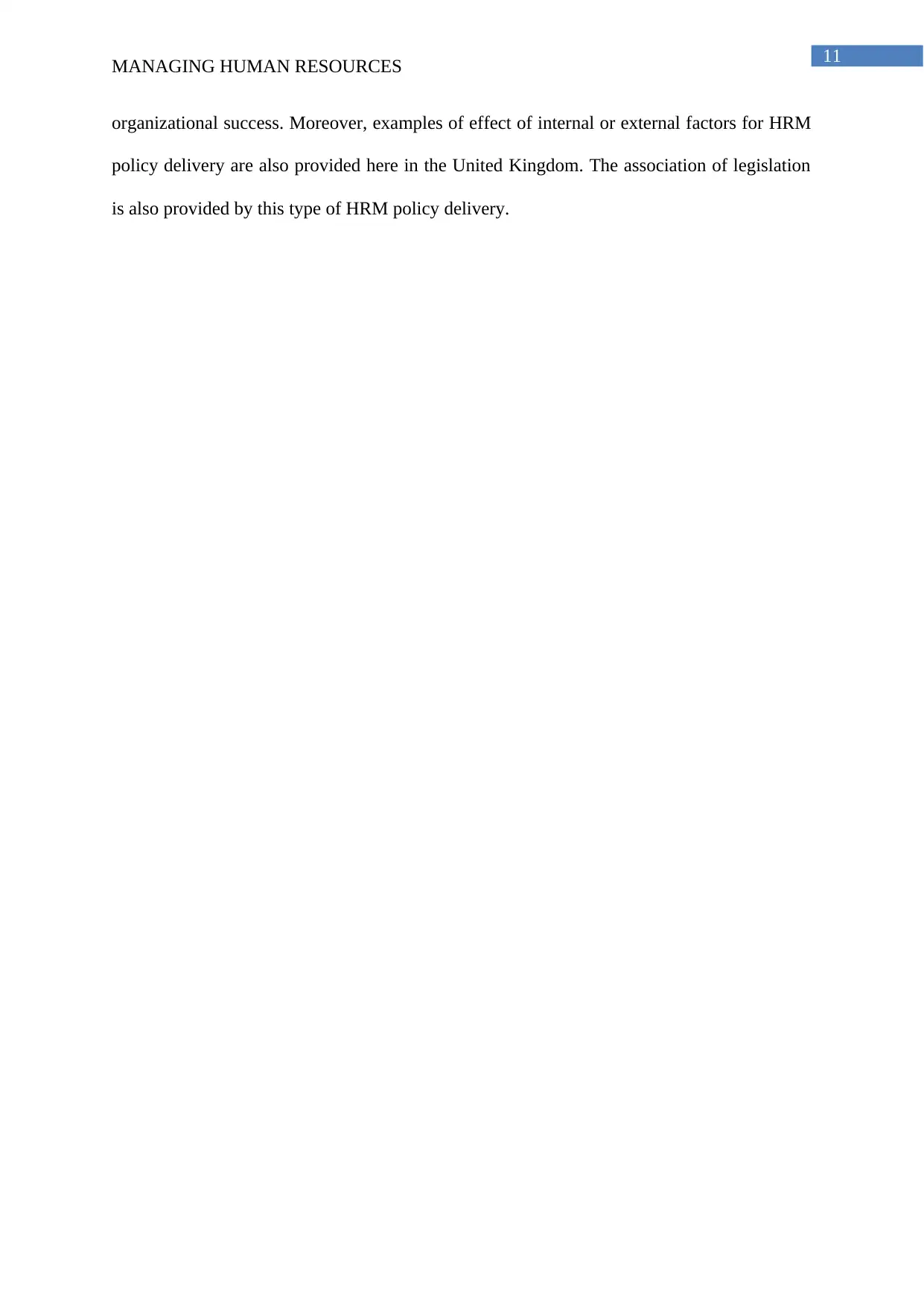
11
MANAGING HUMAN RESOURCES
organizational success. Moreover, examples of effect of internal or external factors for HRM
policy delivery are also provided here in the United Kingdom. The association of legislation
is also provided by this type of HRM policy delivery.
MANAGING HUMAN RESOURCES
organizational success. Moreover, examples of effect of internal or external factors for HRM
policy delivery are also provided here in the United Kingdom. The association of legislation
is also provided by this type of HRM policy delivery.
⊘ This is a preview!⊘
Do you want full access?
Subscribe today to unlock all pages.

Trusted by 1+ million students worldwide
1 out of 15
Related Documents
Your All-in-One AI-Powered Toolkit for Academic Success.
+13062052269
info@desklib.com
Available 24*7 on WhatsApp / Email
![[object Object]](/_next/static/media/star-bottom.7253800d.svg)
Unlock your academic potential
Copyright © 2020–2025 A2Z Services. All Rights Reserved. Developed and managed by ZUCOL.





